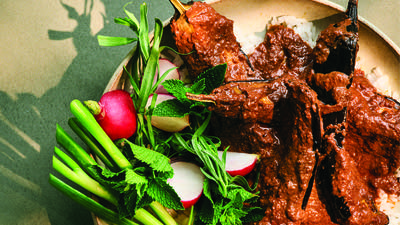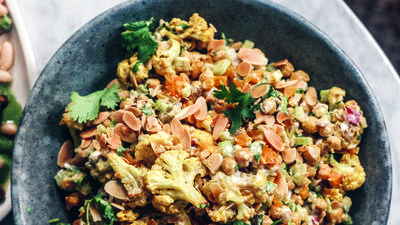
MAKES ONE 900-GRAM LOAF
I created this bread in Israel with Henrietta Lovell, my love. We were invited to do an event that turned out to be a true collaboration, with a lovely man and great chef, Ezra Kedem, in his studio/restaurant, called Arcadia, close to Jerusalem. We paired Ezra’s food with my bread and Henrietta’s iced oolong tea, blended with fresh garden herbs. (If you know anything about Henrietta, you’ll know she is the drinks master, with the most amazing palate. They call her the Tea Lady, but her love and skill extend way beyond tea.)
Arcadia is set on a rural farm, on a beautiful mountainside with spectacular views. The day before the event, I walked around the kitchen garden, totally inspired by what they were growing. I thought that making a rye bread with Ezra’s seasonal farm ingredients was the way to bring our worlds together.
He had a few fig trees on the property, and I wondered what it would be like to line the bread pans with the leaves. It looked amazing and added a great flavor, almost a coconut scent. To make it even more figgy, I’ve added dried figs to this recipe, soaked in tea as a tribute to that day.
INGREDIENTS
Baker ’s Percentage | Quantity | Ingredient
TEA-SOAKED FIGS
 Richard Hart Bread: Intuitive Sourdough Baking
Richard hart
Richard Hart Bread: Intuitive Sourdough Baking
Richard hart
100% | 120g | Dried figs
100% | 120g | Freshly brewed black tea
DOUGH
80% | 192g | Rye flour
20% | 48g | Whole wheat flour
100% | 240g | 12-hour rye starter
60% | 144g | Warm water (82°F / 28°C)
25% | 60g | Yogurt
4% | 10g | Salt
25% | 60g | Coarsely chopped walnuts
60% | 145g | Tea-soaked figs
ADDITIONAL INGREDIENT
Fresh fig leaves
TIMING
Soak figs, mix dough, shape loaf, ferment for 2 to 4 hours, and bake for about 1 hour: 4½ to 6½ hours total
EQUIPMENT
Two large mixing bowls, loaf pan (5 × 9 inches / 13 × 20cm), flexible plastic dough scraper, bowl or pitcher of warm water (for rinsing), digital thermometer, tea towel, sheet pan or shallow roasting pan, cooling rack
Soak the figs in tea: Coarsely chop the figs and place them in a bowl. Pour the hot tea over them and let them soak for 30 minutes. Drain the fruit and set it aside. (If you like, you can drink the tea, or make a black tea and fig syrup by adding sugar in a 1-to-1 ratio and reducing it over high heat.)
Mix the dough: Line the loaf pan completely with the fig leaves, overlapping them as necessary so that there are no gaps.
Make sure your dough scraper and a bowl or pitcher of warm water are close at hand.
In a large bowl, combine all the dough ingredients, including the soaked figs, and use your hands to mix it all together gently to form a thick dough with no dry streaks of flour remaining, at which point you can consider the dough sufficiently mixed. The texture will be similar to a rather wet and sticky Play-Doh. Use the plastic scraper to scrape the dough from your hands back into the bowl, and rinse your hands in the bowl of warm water, along with your scraper.
Shape the dough: Wet your hands, loosen the dough from the bowl with your scraper, and, as if you are shaping clay, squidge the dough together into one mass, then use both hands to shape it into an oblong that’s more or less the shape of the loaf pan but slightly less wide. This dough is easy to manipulate and very forgiving, so don’t worry if you need to mess around with it a bit to get it into the shape.
Gently set the loaf into the fig leaf-lined pan and take its temperature, adjusting it as necessary by setting the pan in a bowl of hot, warm, or cool water to bring it to about 82°F / 28°C. (See Controlling Temperature, page 52.) Pat down any fig leaves that may be jutting out above the level of the dough, enveloping the top surface of the loaf with them.
Ferment the loaf: Let the loaf ferment, covered with a tea towel, for 2 to 4 hours, making sure to keep it warm. When it’s ready to bake, it will have risen by 30% and will have 2mm-wide cracks.
Bake the loaf: Place a sheet pan or shallow roasting pan on the floor of the oven. Arrange a rack in the center of the oven. Preheat the oven to 425°F / 220°C.
Place the loaf in the oven and add about 250ml water to the pan on the oven’s floor, taking care to avoid exposing your skin directly to the resultant steam, which can burn.
Bake the loaf for30 minutes, then rotate the pan front to back and bake foranother30 minutes. Use an instant-read thermometer to take the internal temperature of the loaf. It should read 203°F/ 95°C.If it’s not quite here, give it a few more minutes. Remove the bread from the oven, then turn it out on to a rack to cool for several hours before slicing. Remove the fig leaves before serving; they will have imparted a lovely fig flavor to the bread but are bitter on their own.
Reprinted with permission from Richard Hart Bread by Richard Hart and Laurie Woolever with Henrietta Lovell copyright © 2024. Photographs by Maureen Evans. Published by Clarkson Potter, a division of Penguin Random House, LLC.
When you shop using our links, we earn a small commission. It’s a great way to support public media at no extra cost to you!
Before you go...
Each week, The Splendid Table brings you stories that expand your world view, inspire you to try something new, and show how food connects us all. We rely on your generous support. For as little as $5 a month, you can have a lasting impact on The Splendid Table. And, when you donate, you’ll join a community of like-minded individuals who love good food, good conversation, and kitchen companionship. Show your love for The Splendid Table with a gift today.
Thank you for your support.
Donate today for as little as $5.00 a month. Your gift only takes a few minutes and has a lasting impact on The Splendid Table and you'll be welcomed into The Splendid Table Co-op.



